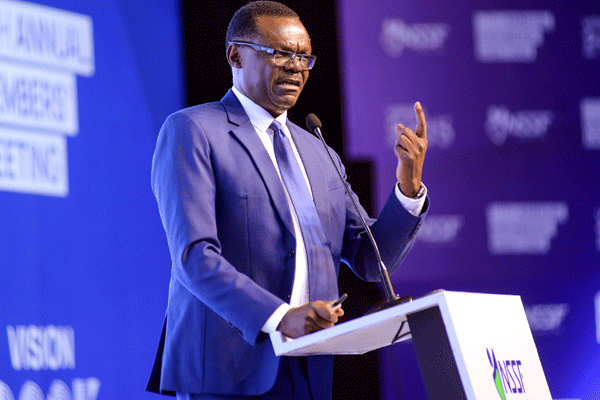
The minister of Finance Matia Kasaija and the Minister of State for Gender, Labour and Social Development (Labour, Employment and Industrial Relations) Davinia Esther Anyakun pose for a group photo with the NSSF managing director Patrick Ayota and other Fund officials during the 12th Annual members meeting in Kampala on September 26, 2024. PHOTOS/ ISAAC KASAMANI
If you had Shs100m in savings, where would you invest it? Would you consider safety first or simply dive into government bonds, or venture into stocks? Maybe your hard-earned savings could find a cosy home in real estate or leave it with the National Social Security Fund (NSSF) and forget about having sleepless nights?
Yesterday, the Minister of Finance, Mr Matia Kasaija, whose ministry oversees the investment aspects of NSSF declared an interest rate of 11.5 percent for the savers, up from 10 percent members received in the financial year 2022/2023.
The interest rate declared by Mr Kasaija, according to NSSF, is above the 10-year average rate of inflation currently at 4.2 percent, and the 2023/2024 inflation which stood at nearly four percent.
In other words, the slightly above Shs2 trillion interest rate, the highest amount of money ever paid in interest to members, hasn’t been weakened by the price changes of goods and services within the 12 months period.
Several analysts commend the NSSF performance describing it as stellar while the Ministry of Finance refers to it as a good return with Minister Kasaija stressing that “it is a job well done”.
However, what if you saved elsewhere other than the Fund, would you recoup the same return on your investment? Saving schemes can also provide a reliable method for growing funds through regular, small investments.
These options, which the Fund through a voluntary savings scheme has since adopted, could also yield higher returns than traditional saving accounts, given that they are also characterised by low risk and consistent returns.
“While NSSF’s 11.5 percent return may appear modest compared to other options like real estate, bonds, or equities, it offers unique advantages such as low risk, tax efficiency, and consistent compounding over time. For individuals looking for safe, stable, and long-term growth, NSSF is an excellent choice,” Mr Kevin Abuka, the manager of Investment Advisory at ASIGMA, a management and financial advisory firm, says.
He adds: “However, for those who have larger sums to invest upfront and are willing to take on more risk or seek shorter-term liquidity, options like bonds, or real estate could potentially offer higher returns but come with trade-offs such as higher risk, and taxation.”
Mr Abuka told Daily Monitor yesterday: “The best option depends on one’s financial goals, risk tolerance, and need for liquidity. This is because a diversified approach that balances NSSF contributions with other investments can provide both stability and growth opportunities.”
Mr Alex Kakande, a financial markets analyst and an auditor with Ernst & Young, says if we are to compare the interest rates between what NSSF gives and what many unit trusts on the market give, unit trusts pay more than 11.5 percent annual interest and their fact sheets show that for some of them, this figure reaches 12 percent.
Unit Trust
According to Mr Enock Twinoburyo, an economist and currently a consultant at SDG Center for Africa based in Kigali, Rwanda, the interest earnings on unit trusts are about what NSSF is offering which is also comparable with net earnings on treasury bills.
He says longer term investments fetch more, noting: “As you notice majority of NSSF investment is in fixed income. And our equities haven’t really garnered actively both on dividends and share price appreciation.”
Mr Denis Kizito, the director of market research at Capital Markets Authority, says unit trusts also give to someone who invested in them compound interest and the fact that these firms do allocate their savers a daily interest rate.
This, he explains, gives collective investment firms, whose closest equivalent to the NSSF’s offerings is the umbrella fund, an advantage over the national pension fund.
“You look at the cumulative annual growth rate of umbrella funds of these collective investment schemes and you compare it with the rate that NSSF gives its saves,” Mr Kizito says.
Mr Nicholas Arinaitwe, a consultant with Real Estate Institute of East Africa (REIEA), says real estate, given its high risk nature, will deliver higher returns on investment compared to many investment schemes.
“It is about the principle of high-risk, high-return, and the real estate sector is all about that. Because of the high rate of risk, the rate of return on investment is also high. If everything goes as planned, you can churn out up to 25 percent interest rate in profit,” Mr Arinaitwe says.
“If you develop a property and sell it within a year as planned, you can generate up to 25 percent in profit. And if no one buys it, it will still appreciate and when you eventually let it you will still be way above 11.5 percent,” he adds.
Mr Lazarus Mugabi, a board member of the Association of Real Estate Agents Uganda, says you can get a 22 percent return if you played your cards right in the real estate market with Shs100m at hand.
This could happen if the investor bought land in a market friendly place like Wakiso District and then divided it into small plots for sale at a small affordable price in a year or even built and sold a condominium whose occupancy rate is active at the moment.
“There you can get quick returns on that money and get returns that are between 10 and 22 percent. But otherwise you would need big money like $1m investments because renting takes hard to recoup returns and that can even last a decade,” he says.
The sector, however, is volatile and could end badly for you.
Fixed deposits
Fixed deposits are a type of investment where you deposit a sum of money with a financial institution, like a bank, for a fixed period at a predetermined interest rate. Unlike savings accounts, fixed deposits lock your money in for a specific time (for example a few months, a year, or more), and in exchange, you earn a higher interest rate.
Most of their interest rates on the market range between eight and 10 percent because it changes per bank, but this figure even goes up to 12 percent if a depositor would want to lock in their Shs2b, which the depositor can’t give out cheaply.
Currently, their returns for a saver with about Shs100m is lower than the 11.5 percent interest rates that NSSF gave out.
Suppose you invest Shs100m in a fixed deposit for a year at an interest rate of 10 percent. By the end of the year, you would receive Shs110m (the original amount plus Shs10m in interest). Early withdrawal could cost you some interest due to penalties.
Fixed deposits are a good option for conservative investors who prioritise security over high returns. They’re especially appealing during times of economic uncertainty when other investments, like stocks, might be too risky.
Dollar investments
Dollar investments offer a cushion against local currency fluctuations, making them appealing in unstable economies. However, they can be risky if the dollar weakens or if global markets are volatile. Returns may be lower compared to high-risk local investments, but they provide stability and protection against inflation or currency depreciation.
People who had decided to invest in the dollar assets like in the US bond market a year back got a return of around four percent per annum in dollar terms and some of those are the ones in the dollar trust funds like one of UAP Old Mutual and Britam.
“This return is pegged on the US Fed rate which hovers between five and 5.35 percent. But the interest rate on the NSSF for last year’s savers which is 11.5 percent is better because it’s in Uganda shillings and not subjected to currency depreciations,” says Cindy Hannah Akankunda, a portfolio manager with ICEA LION Group Uganda, an asset manager.
Mr Ayota Patrick, NSSF’s managing director, says the Fund is not competing with these other asset managers like unit trusts that don’t generally sell their products on the idea of selling from the mid to long term but months, yet the Fund is very purposeful on long term savings.
“You can take it where you want it to go if you want to remove it tomorrow, but if you look at strategic savings like a goal on health, education or any other. Then the discipline of that is in NSSF. The design is specifically to encourage us to shift from just saving for the short term but with that mid-range and the long term,” he explained.
Good and bad news
For a voluntary member starting to save with NSSF Uganda in July 2023, their contributions would earn “zero interest” from July 2023 to June 2024. This is due to NSSF’s rule that applies interest only to the balance that was outstanding one year prior.
“This means that new contributions do not earn interest in the first year. In contrast, Unit Trusts, which offer compounding interest on a monthly basis, would be more attractive to voluntary savers, as they begin earning returns immediately without a delay,” Mr Alex Kakande, a finance and investment analyst, says.
This is because as per Section 36 (1) of the NSSF Act, the new interest is calculated and credited on the balance outstanding on the members’ accounts as at July 1, 2023
According to Mr Paul Corti Lakuma, a senior research fellow at Economic Policy Research Centre (EPRC), NSSF is a compulsory provident fund for formal workers and not a typical investment fund.
He says: “I do think it’s possible at the moment to access your money and invest it in an alternative instrument unless the sector is liberalised so that workers can pick an alternative institution that addresses their risk tolerance. At the moment the law provides only for one institution. Also, 11.5 percent for a retirement fund is a very competitive rate.”
Other options beyond the Fund, according to economist Fred Muhumuza, also former advisor in the Ministry of Finance, only Treasury bills and fiscal bonds will do better considering that even NSSF largely invests there.
Diversify
The managing director of Alpha Capital Partners, Mr Stephen Kaboyo, says with NSSF’s current site and scale, it is critical that the Fund realigns its asset classes and aggressively consider new types of investment vehicles.
“Such investments cover a wide range, from economic infrastructure such as all types of transport including railway which is seen as a major gap in the country’s transport systems. Another potential area is in social projects such as specialised hospitals that are also absent in the country,” Mr Kaboyo, who is also the director of financial markets at Bank of Uganda, says.
He adds: “The above investments offer high growth play with long term investment return goals, and offer a good choice as far as portfolio diversification is concerned ...Investment horizon keeps changing, episodes of high volatility have become more frequent, one good year is not necessarily a trend in markets.”




